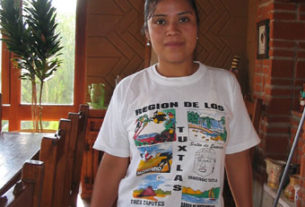Although I have had the privilege of working with many fine chefs and cooking teachers here in Mexico, my favorite culinary experiences have been with home cooks in their own kitchens. From humble outdoor kitchens in the Sierra, where all cooking is still done over an open fire, to state-of-the-art cooking centers in upscale homes, I have learned that the basic tools and techniques of the Mexican kitchen have changed astonishingly little in the seven thousand years since maize, chiles and squash were first domesticated. The ancient forms of cooking equipment are still very much in use, along with their time- and labor-saving modern counterparts. This is due in great part to the fact that corn was and is the basic staple food of Mexico, and the preparation of corn dough the earliest and most basic culinary technique.
In pre-Hispanic times, the southern Gulf coast-dwelling Olmecs cooked corn by boiling or popping, and it was most likely in the central plateau that corn was first made into dough and baked to make tortillas and tamales.
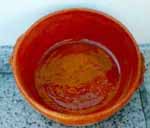 The first step, boiling the dried corn kernels, was done in a CAZUELA, an earthenware pot still widely used in Mexico for boiling corn, moles, guisados-stews- and especially beans. Beans cooked in a cazuela have a far superior taste to those boiled in metal or enameled pots. Although the OLLA EXPRESS – pressure cooker- has found a place in an overwhelming number of modern Mexican kitchens, many cooks transfer the beans to a clay cazuela for the last part of the cooking after they have softened sufficiently in the pressure cooker. Beans, which became domesticated at about the same time as corn, do not require any other utensil than the same type of cazuela or pressure cooker in which the corn is cooked.
The first step, boiling the dried corn kernels, was done in a CAZUELA, an earthenware pot still widely used in Mexico for boiling corn, moles, guisados-stews- and especially beans. Beans cooked in a cazuela have a far superior taste to those boiled in metal or enameled pots. Although the OLLA EXPRESS – pressure cooker- has found a place in an overwhelming number of modern Mexican kitchens, many cooks transfer the beans to a clay cazuela for the last part of the cooking after they have softened sufficiently in the pressure cooker. Beans, which became domesticated at about the same time as corn, do not require any other utensil than the same type of cazuela or pressure cooker in which the corn is cooked.
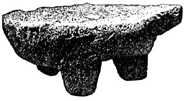 The wet corn, once cooked in the cazuela with mineral lime, which loosened the husks covering each kernel, was ground on a stone called a METATE, which resembled a small, sloped three-legged table. In rural Mexico, and among very traditional cooks, the metate is still used to grind corn for home made tortillas, which taste so much better than the commercial variety. It is also used to grind moles, pipianes and recados, regional seasoning pastes and sauces, although home cooks preparing food in quantity normally rely on the molinillo- neighborhood mill- to grind the ingredients they bring from home.
The wet corn, once cooked in the cazuela with mineral lime, which loosened the husks covering each kernel, was ground on a stone called a METATE, which resembled a small, sloped three-legged table. In rural Mexico, and among very traditional cooks, the metate is still used to grind corn for home made tortillas, which taste so much better than the commercial variety. It is also used to grind moles, pipianes and recados, regional seasoning pastes and sauces, although home cooks preparing food in quantity normally rely on the molinillo- neighborhood mill- to grind the ingredients they bring from home.
After the corn had been ground it was, and still is, patted into flat cakes of various thicknesses, traditionally formed by hand but but now most often flattened out on a wooden or metal PRENSA, or tortilla press. It was then baked on the COMAL, the final utensil essential to tortilla-making. It was found in one form or another, including the flat clay griddle of the Aztecs and the stone slabs of the Maya, in nearly all of Mesoamerica. The comal is still used on a daily basis in most homes, even if only to reheat commercial tortillas. Many are now made of metal, although clay is still used, especially in the southern part of the country. The comal, throughout Mexican culinary history, has served as a surface on which to cook not only tortillas but chiles, tomatoes and other condiments, for while the tortilla was the staple food, tamales were the feasting food, and required the preparation of a variety of salsas and fillings.
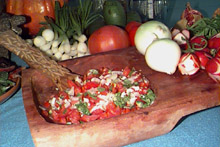 These salsas were, and still are, prepared in a volcanic stone or clay mortar called a MOLCAJETE. This utensil is essentially a sauce bowl, the salsa being prepared by grinding the ingredients together. While the LIQUADORA – blender – has taken over much of the work of the molcajete, its purpose is essentially the same, to pulverize ingredients. The modern housewife relies on the blender to do this work, but the use of the molcajete as a functioning kitchen utensil has had a surge in popularity in recent years, thanks in part to nouvelle Mexican cuisine, with its emphasis on pre-Hispanic culinary techniques. In fine restaurants in Mexico, as well as Mexican restaurants in other countries, salsas are blended at the table and served from the molcajete. In many rural areas, the blender has never replaced the molcajete for making sauces, and the results are usually superior.
These salsas were, and still are, prepared in a volcanic stone or clay mortar called a MOLCAJETE. This utensil is essentially a sauce bowl, the salsa being prepared by grinding the ingredients together. While the LIQUADORA – blender – has taken over much of the work of the molcajete, its purpose is essentially the same, to pulverize ingredients. The modern housewife relies on the blender to do this work, but the use of the molcajete as a functioning kitchen utensil has had a surge in popularity in recent years, thanks in part to nouvelle Mexican cuisine, with its emphasis on pre-Hispanic culinary techniques. In fine restaurants in Mexico, as well as Mexican restaurants in other countries, salsas are blended at the table and served from the molcajete. In many rural areas, the blender has never replaced the molcajete for making sauces, and the results are usually superior.
 The tamales for which these sauces were originally made were steamed in a type of cazuela called an OLLA, a deep, handled clay steamer. Although aluminum steamers called VAPORERAS have taken their place in preparing tamales and other steamed food, ollas are still very much in use today for preparing sweetened coffees and punches. Similar recipients, made of hand-painted jicaras, or gourds, are still used for serving the traditional frothy chocolate drinks which are whipped with a wooden hand beater called a MOLINILLO.
The tamales for which these sauces were originally made were steamed in a type of cazuela called an OLLA, a deep, handled clay steamer. Although aluminum steamers called VAPORERAS have taken their place in preparing tamales and other steamed food, ollas are still very much in use today for preparing sweetened coffees and punches. Similar recipients, made of hand-painted jicaras, or gourds, are still used for serving the traditional frothy chocolate drinks which are whipped with a wooden hand beater called a MOLINILLO.
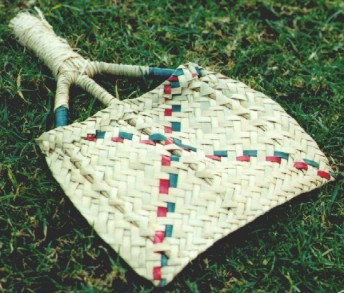 In ancient times, the cooking fire was contained in a very simple hearth, consisting of three stones over which the comal, cazuela or olla was placed. This fireplace was the most sacred part of the home, with the three stones representing the “fire dogs”- Mizcoatl, Tozpan and Iiutl- guardians of the fire god Huehueteotl. Many indigenous women still “feed” the firedogs before starting the morning fire, throwing pieces of tortilla into the flames and fanning them with a SOPLADOR, a woven palm fan. This fan is also used with the portable brazier called an ANAFRE, on which a grate called a PARILLA is placed to grill meat. High regard and respect for the culinary arts prevails in modern Mexican home kitchens as well. Today’s Mexican kitchen, whether an ultra-modern showplace, a Talavera tile-covered colonial gem, or a humble outdoor lean-to, is still the heart and soul of the house.
In ancient times, the cooking fire was contained in a very simple hearth, consisting of three stones over which the comal, cazuela or olla was placed. This fireplace was the most sacred part of the home, with the three stones representing the “fire dogs”- Mizcoatl, Tozpan and Iiutl- guardians of the fire god Huehueteotl. Many indigenous women still “feed” the firedogs before starting the morning fire, throwing pieces of tortilla into the flames and fanning them with a SOPLADOR, a woven palm fan. This fan is also used with the portable brazier called an ANAFRE, on which a grate called a PARILLA is placed to grill meat. High regard and respect for the culinary arts prevails in modern Mexican home kitchens as well. Today’s Mexican kitchen, whether an ultra-modern showplace, a Talavera tile-covered colonial gem, or a humble outdoor lean-to, is still the heart and soul of the house.
Whether the individual cook uses traditional methods and materials, or combines them with the use of time-saving appliances, most take great care, pride and planning in the preparation of meals.
Next month, Part II of this look at the Mexican kitchen will focus on cooking techniques and provide recipes learned from some little-known but outstanding Mexican home cooks


